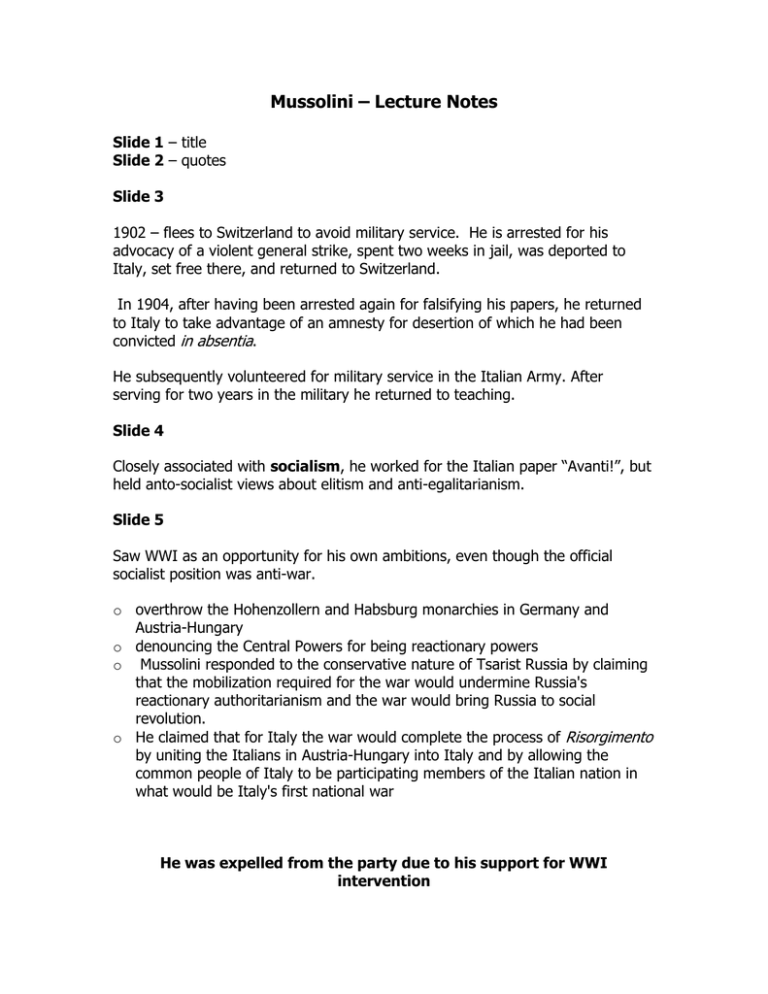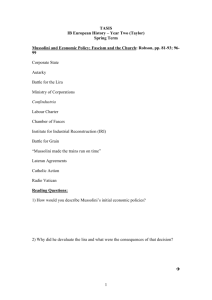Mussolini – Lecture Notes
advertisement

Mussolini – Lecture Notes Slide 1 – title Slide 2 – quotes Slide 3 1902 – flees to Switzerland to avoid military service. He is arrested for his advocacy of a violent general strike, spent two weeks in jail, was deported to Italy, set free there, and returned to Switzerland. In 1904, after having been arrested again for falsifying his papers, he returned to Italy to take advantage of an amnesty for desertion of which he had been convicted in absentia. He subsequently volunteered for military service in the Italian Army. After serving for two years in the military he returned to teaching. Slide 4 Closely associated with socialism, he worked for the Italian paper “Avanti!”, but held anto-socialist views about elitism and anti-egalitarianism. Slide 5 Saw WWI as an opportunity for his own ambitions, even though the official socialist position was anti-war. o overthrow the Hohenzollern and Habsburg monarchies in Germany and Austria-Hungary o denouncing the Central Powers for being reactionary powers o Mussolini responded to the conservative nature of Tsarist Russia by claiming that the mobilization required for the war would undermine Russia's reactionary authoritarianism and the war would bring Russia to social revolution. o He claimed that for Italy the war would complete the process of Risorgimento by uniting the Italians in Austria-Hungary into Italy and by allowing the common people of Italy to be participating members of the Italian nation in what would be Italy's first national war He was expelled from the party due to his support for WWI intervention Slide 6 Mussolini would found two newspapers Mussolini continued to promote the need of a revolutionary vanguard elite to lead society, but he no longer advocated a proletarian vanguard but instead a vanguard led by dynamic and revolutionary people of any social class. Fascism arose out of his belief that national identity and loyalty were in fact of greater significance than any class distinction. In 1914 the newly formed political movement, Fasci Rivoluzionari d'Azione Internazionalista in 1914, who called themselves Fascisti (Fascists), was formed Slide 7 Mussolini then entered the military and served in the war. His military exploits ended in 1917 when he was wounded accidentally by the explosion of a mortar bomb in his trench. He was left with at least 40 shards of metal in his body. Slide 8 On 25 December 1915, he married Rachele Guidi, who had already born him a daughter, Edda, at Forli in 1910. In 1915, he had a son with Ida Dalser, a woman born in Sopramonte, a village near Trento. He may have been married to her prior to marrying Guidi, but there are no documents proving this. He legally recognized this son on 11 January 1916. Slide 9 On 23 March 1919, Mussolini reformed the Milan fascio as the Fasci Italiani di Combattimento (Italian Combat Squad), consisting of 200 members Slide 10 Believed in: rule by an elite promoting the state as the ultimate end, opposition to democracy, protecting the class system and promoting class collaboration, rejection of egalitarianism, promoting the militarization of a nation by creating a class of warriors, demanding that citizens perform civic duties in the interest of the state, utilizing state intervention in education to promote the creation of warriors and future rulers of the state Slide 11 The Fascisti, led by one of Mussolini's close confidants, Dino Grandi, formed armed squads of war veterans called Blackshirts (or squadristi) with the goal of restoring order to the streets of Italy with a strong hand. The blackshirts clashed with communists, socialists, and anarchists at parades and demonstrations; all of these factions were also involved in clashes against each other Slide 12 Blackshirts were usually ex-soldiers and it was their job to bring into line Mussolini’s opponents. They murdered Matteotti, who spoke out in parliament, denouncing the fascists. The motto of the Blackshirts was “Me ne frego” (I do not give a damn) They were probably less feared than Hitler’s SA (Brownshirts), although they did maintain an iron rule. One favoured way of making people conform was to tie them to a tree, force a pint of castor oil down their throat and force them to eat a live toad. The murderous tactics used by the Gestapo and SS were rare in Italy. Slide 13 By 1921 his party had 300 000 members, but only 35/535 seats in parliament Chaos in public life continued October, 1922 – 26 000 troops threaten to march on Rome and force gov’t to restore order Parliament asks King Emmanuel III to sign an emergency decree He refuses, fearing civil war, instead asking Mussolini to form the government In 1926 three assassination attempts were made on the Italian prime minister. 11 September of that year Gino Lucetti hurled a bomb at Mussolini’s armoured car, October 31 Anteo Zamboni, a brave fifteen year old, shot at the Duce as Mussolini marched in a parade in Bologna. Lucetti was sent to prison for 30 years: in almost any western democracy in that period he would have been sentenced to death. Zamboni, on the other hand, was ‘lynched’ on the spot April 7 1926, Violet Gibson, a fifty year old maiden aunt and the daughter of an Irish Lord, Edward Gibson (obit 1913), went for a walk in central Rome. God had recently been speaking to Violet and she had a pistol in her pocket. In Piazza del Campidoglio she came upon Mussolini, who was saluting the crowd. She slipped past his security guards, as only maiden aunts can, and got within a foot of the Italian dictator, shooting at his head. A slight movement on Mussolini’s part – he was turning to greet another part of the crowd – saved the Italian: the bullet grazed his nose –Then Violet’s second bullet stuck in the chamber… Violet was lucky and yet unluckier. The crowd beat her before she was arrested – her fate was almost that of the young Zamboni. The Italian authorities, however, with a judicial respect for mental illness that has characterised the peninsula since the Renaissance, quickly surrendered her to the British who had Violet placed in an asylum. She had already walked down the long white corridors of mental institutions earlier in her life and she would now spend the rest of her days (obit 1956) in an asylum in Northamptonshire (UK).



